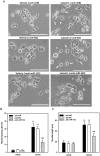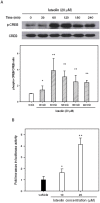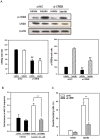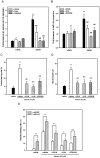Luteolin induces microRNA-132 expression and modulates neurite outgrowth in PC12 cells
- PMID: 22916239
- PMCID: PMC3420912
- DOI: 10.1371/journal.pone.0043304
Luteolin induces microRNA-132 expression and modulates neurite outgrowth in PC12 cells
Abstract
Luteolin (3',4',5,7-tetrahydroxyflavone), a food-derived flavonoid, has been reported to exert neurotrophic properties that are associated with its capacity to promote neuronal survival and neurite outgrowth. In this study, we report for the first time that luteolin induces the persistent expression of microRNA-132 (miR-132) in PC12 cells. The correlation between miR-132 knockdown and a decrease in luteolin-mediated neurite outgrowth may indicate a mechanistic link by which miR-132 functions as a mediator for neuritogenesis. Furthermore, we find that luteolin led to the phosphorylation and activation of cAMP response element binding protein (CREB), which is associated with the up-regulation of miR-132 and neurite outgrowth. Moreover, luteolin-induced CREB activation, miR-132 expression and neurite outgrowth were inhibited by adenylate cyclase, protein kinase A (PKA) and MAPK/ERK kinase 1/2 (MEK1/2) inhibitors but not by protein kinase C (PKC) or calcium/calmodulin-dependent protein kinase II (CaMK II) inhibitors. Consistently, we find that luteolin treatment increases ERK phosphorylation and PKA activity in PC12 cells. These results show that luteolin induces the up-regulation of miR-132, which serves as an important regulator for neurotrophic actions, mainly acting through the activation of cAMP/PKA- and ERK-dependent CREB signaling pathways in PC12 cells.
Conflict of interest statement
Figures










Similar articles
-
Up-Regulation of miR-34a Expression in Response to the Luteolin-Induced Neurite Outgrowth of PC12 Cells.J Agric Food Chem. 2015 Apr 29;63(16):4148-59. doi: 10.1021/acs.jafc.5b01005. Epub 2015 Apr 20. J Agric Food Chem. 2015. PMID: 25865700
-
Neurotrophic effect of citrus 5-hydroxy-3,6,7,8,3',4'-hexamethoxyflavone: promotion of neurite outgrowth via cAMP/PKA/CREB pathway in PC12 cells.PLoS One. 2011;6(11):e28280. doi: 10.1371/journal.pone.0028280. Epub 2011 Nov 29. PLoS One. 2011. PMID: 22140566 Free PMC article.
-
Neurotrophic and cytoprotective action of luteolin in PC12 cells through ERK-dependent induction of Nrf2-driven HO-1 expression.J Agric Food Chem. 2010 Apr 14;58(7):4477-86. doi: 10.1021/jf904061x. J Agric Food Chem. 2010. PMID: 20302373
-
Sustained activation of M-Ras induced by nerve growth factor is essential for neuronal differentiation of PC12 cells.Genes Cells. 2006 Sep;11(9):1097-113. doi: 10.1111/j.1365-2443.2006.01002.x. Genes Cells. 2006. PMID: 16923128
-
The transcription factors CREB and c-Fos play key roles in NCAM-mediated neuritogenesis in PC12-E2 cells.J Neurochem. 2001 Dec;79(6):1149-60. doi: 10.1046/j.1471-4159.2001.00636.x. J Neurochem. 2001. PMID: 11752056
Cited by
-
Role of dietary phenols in mitigating microglia-mediated neuroinflammation.Neuromolecular Med. 2016 Sep;18(3):453-64. doi: 10.1007/s12017-016-8430-x. Epub 2016 Jul 27. Neuromolecular Med. 2016. PMID: 27465151 Review.
-
miR-124 promotes the neuronal differentiation of mouse inner ear neural stem cells.Int J Mol Med. 2016 Nov;38(5):1367-1376. doi: 10.3892/ijmm.2016.2751. Epub 2016 Sep 27. Int J Mol Med. 2016. PMID: 28025992 Free PMC article.
-
Luteolin, a natural flavonoid, inhibits methylglyoxal induced apoptosis via the mTOR/4E-BP1 signaling pathway.Sci Rep. 2017 Aug 11;7(1):7877. doi: 10.1038/s41598-017-08204-6. Sci Rep. 2017. PMID: 28801605 Free PMC article.
-
Inhibition of miR-134 Protects Against Hydrogen Peroxide-Induced Apoptosis in Retinal Ganglion Cells.J Mol Neurosci. 2015 Jun;56(2):461-71. doi: 10.1007/s12031-015-0522-9. Epub 2015 Mar 6. J Mol Neurosci. 2015. PMID: 25744098
-
Luteolin Induced Hippocampal Neuronal Pyroptosis Inhibition by Regulation of miR-124-3p/TNF-α/TRAF6 Axis in Mice Affected by Breast-Cancer-Related Depression.Evid Based Complement Alternat Med. 2022 May 6;2022:2715325. doi: 10.1155/2022/2715325. eCollection 2022. Evid Based Complement Alternat Med. 2022. PMID: 35571739 Free PMC article.
References
-
- Ambros V (2008) The evolution of our thinking about microRNAs. Nat Med 14: 1036–1040. - PubMed
-
- Lim LP, Lau NC, Garrett-Engele P, Grimson A, Schelter JM, et al. (2005) Microarray analysis shows that some microRNAs downregulate large numbers of target mRNAs. Nature 433: 769–773. - PubMed
-
- Bartel DP (2004) MicroRNAs: genomics, biogenesis, mechanism, and function. Cell 116: 281–297. - PubMed
Publication types
MeSH terms
Substances
LinkOut - more resources
Full Text Sources
Miscellaneous

